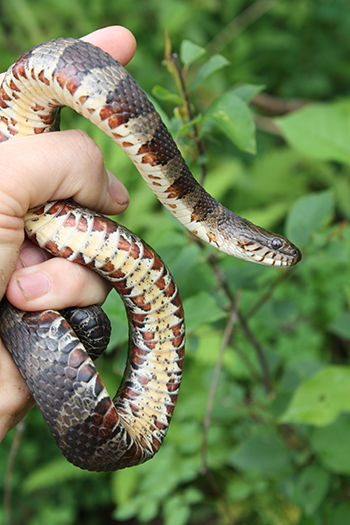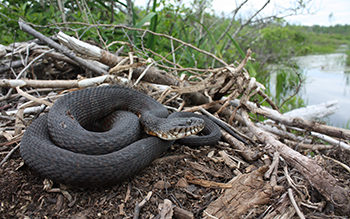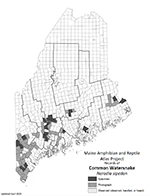Home → Fish & Wildlife → Wildlife → Species Information → Reptiles & Amphibians → Common Watersnake
Common Watersnake
Nerodia sipedon
On this page:

Photo: Trevor Persons
Distinguishing Characteristics
- Large and thick-bodied, approximately 24 to 48 inches in length
- Dark brown to gray above with reddish-brown to black blotches or bands
- Large belly scales with dark red or black half-moons
- Dorsal scales keeled (longitudinal raised ridge along midline of each scale)
- Older adults often appear all-black when dry and on land, and sometimes confused with North American racer
Status and Distribution in Maine
- Common and secure
- Southern, central, and eastern regions
Habitat

Photo: Trevor Persons
- Still or slow-moving water of lakes, ponds, and streams
- Open-canopy aquatic habitats with emergent vegetation and basking areas such as rocks, logs, and beaver dams and lodges
Diet
- Eats mostly fish, also amphibians and invertebrates
Seasonal Changes
- Usually hibernates near water, in rocks, beaver dams, or in beaver or muskrat tunnels along stream banks
Natural History Notes
- Most aquatic snake in Maine
- Breeds in April, May, and the early fall, sometimes breeding in a mating ball composed of several snakes
- Gives birth to live young from August through October
- Writhes, bites, and voids feces when handled, but like all Maine snakes is non-venomous
Share Your Sighting
There is much still to learn about the distribution and ecology of Maine’s herpetofauna, and we encourage members of the public to share their photo-documented observations as part of the Maine Amphibian & Reptile Atlas Project (MARAP).
To see if a township still needs documentation of a species, consult this distribution map (PDF). If a township lacks a photo or specimen record, we want your observation!
There are two ways to share your observations:
Submit your reptile or amphibian observation online
No service? No problem. Click here to download the survey to your device while connected, then take offline to collect observations from anywhere. Tip: The survey works best on Google Chrome and Safari.
Or upload sightings to the iNaturalist citizen science project through their website at iNaturalist.org or mobile app.
- When submitting an observation through iNaturalist add a description of the location (and other noteworthy information) to the “notes” field. This serves as a check on the locations automatically generated by smartphone cameras, which may be imprecise if cell service or GPS coverage is weak.
Thank you for doing your part to help conserve Maine’s reptiles and amphibians.
